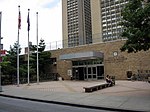Washington Square Village

Washington Square Village (WSV) is an apartment complex in a superblock in the Greenwich Village neighborhood of Manhattan, New York City. WSV was developed by Paul Tishman and Morton S. Wolf. To design the housing complex, the developer selected architects S. J. Kessler and Sons, with Paul Lester Weiner as consultant for site planning and design; landscape architects were Sasaki, Walker & Associates. WSV contains 1,292 apartments in two parallel tower slabs of two buildings each, enclosing a park over a 650-car underground garage. WSV represents the epitome of the tower in a park approach to housing. The complex features vertical panels of bold, primary-color glazed bricks, and terraces. It is owned by New York University and houses faculty members, graduate students, and other members of the community. WSV is bounded by West 3rd Street, Bleecker Street, Mercer Street and LaGuardia Place to the north, south, east and west respectively. It is traversed by two driveways of which the westerly one was formerly part of Wooster Street, and the easterly, Greene Street.
Excerpt from the Wikipedia article Washington Square Village (License: CC BY-SA 3.0, Authors, Images).Washington Square Village
Washington Square North, New York Manhattan
Geographical coordinates (GPS) Address Nearby Places Show on map
Geographical coordinates (GPS)
| Latitude | Longitude |
|---|---|
| N 40.728055555556 ° | E -73.997222222222 ° |
Address
New York University
Washington Square North
10012 New York, Manhattan
New York, United States
Open on Google Maps


